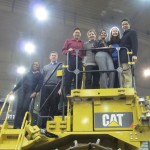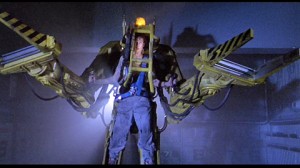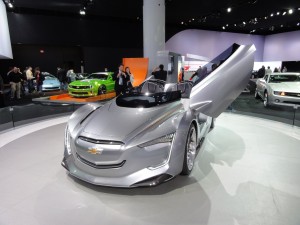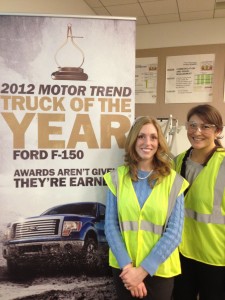This January, the LGO Class of 2013 is taking part in the program’s signature learning adventure: the Domestic Plant Trek, an annual two-week, nationwide visit to the shop floors of LGO partner companies’ most important facilities. The trek started in Peoria, Illinois, at Caterpillar’s factory and massive demonstration center. While I missed the
chance to join the LGOs atop gigantic Caterpillar machines and witness remote-controlled mayhem simulated operations, I was able to join up with them as they arrived the next evening in Detroit for an intensive visit to GM, Ford, and the International Auto Show. It has been an awesome opportunity so far to walk through these global companies’ leading facilities, to hear their executives and union staff talk about daily challenges, and to see all this through the eyes of 52* extremely perceptive and fun LGOs.
At 0700 on Wednesday morning, the LGO group was about 90 minutes into the day and was greeted by the plant manager of GM’s Lansing Delta Township factory with a hearty “Welcome to operations hours!” LDT is one of GM’s newest facilities, and produces crossover vehicles across several GM brands. Despite the turmoil in the auto industry in the past few years, the management and UAW workers at LDT were quite upbeat, and distinctly proud of their product and of the facility. It was a homecoming for Brent Yoder ’13, who worked at LDT for two years before moving to Amazon and then to MIT.
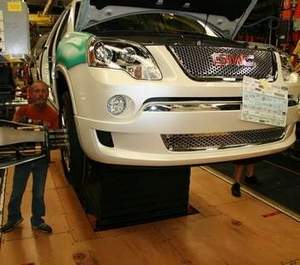
The final assembly line at LDT showing an operator on the palletized line and a vehicle up on a "skillet" (Photo: GM Company)
We spent the full day at the factory, starting (for my group) with a tour of the entire facility from the stamping shop through to the body shop and general assembly: from metal plates to trucks driving off the line, the full process takes about 18 hours. Our group’s guide was a UAW team leader with 30 years in GM, who took pleasure in showing our group the site and explaining the many improvements in the production system and worker conditions since “the old days.”
The stamping shop was a good place to start in terms of orienting lay observers like me to the physical scale of auto manufacturing. The LDT stamping shop is focused on two block-long presses (one from Japan, one from Germany) that cost about $35M each and have multi-ton dies that can be switched out within 15 minutes. Most dies press several parts at a time, which flow out the end of the machine to where operators sort them onto racks on turntables. The stamped pieces are offloaded either to huge inventory racks, to trucks destined for remote GM sites, or directly into the adjacent body shop. The stamping shop leader pointed with pride to the progress board on the wall as evidence that they were on their way to exceeding the day’s goal.
Around the corner in the body shop, we beheld the results of GM’s focus on automation: a huge field of robotic assembly cells, some of them sheathed in plastic to avoid sparks or fluids flying out into the aisles, all whirring and welding in a way that reminded a few of us of “The Terminator” (final scene in a factory, “You’re terminated,” red spark of malevolent AI in the T100’s remaining eye finally extinguished by Sarah Connor using a massive machine press). Of course, the (human) operators in the body shop are needed for quality control and testing—including UV testing of welds—but for sure this area of the plant was the maximal example of automation. Interestingly, one of the questions the faculty raised afterwards was a suggestion to the LGOs to ask how the decisions are made to have more or less automation. Each company has its own cultural affinity for a given balance of robotics and human labor.
In the general assembly shop, the better movie analogy might be the big assisted loader that Ripley climbs into at the end of “Aliens” for her battle with the alien queen. While there are many advances that were noted in the manufacturing system, such as the layout of the line and the flow of supplies from vendor trucks right onto the line for assembly, a striking difference from the old-school assembly line is the use of assistive technology to improve operator ergonomics and line efficiency. The vehicles move through the line on “skillets,” platforms that can adjust up and down to suit the height of the operator and the specific task so as to minimize crouching and stretching. Instead of walking alongside the conveyor, there are wooden pallets surrounding each skillet to allow the operators to stand and be moved along with the vehicle. Stations that require installing tires or other heavy components have lifts. Maybe the coolest hybrid-human innovation is an articulated seat that pivots operators into the vehicle cabin to install interiors without crawling, kneeling or otherwise getting yourself closer to disability or retirement. All this was evidence of GM’s business calculation to invest in improved operator conditions.
After the tour and a panel discussion over lunch with plant management, my group went through an accelerated version of the training given to new operators in the Simulated Work Environment. GM and the UAW created a miniature assembly line with wooden body

The Japanese fishermen used to hang a lantern, or "andon," on the boat when they needed help unloading. This has become the term for the system line workers use to ask for help.
frames and parts, real bolts and electric drills, a real “andon” (help) pull cord and progress board, and real application of the plant’s goals for safety, quality and other metrics. For the LGOs, this was a step beyond the production simulation using LEGOs they had conducted in their summer ESD.930 module on Lean 6-Sigma Methods. We did one 10-minute stint and reviewed our extremely poor metrics, and were asked to think about process improvements for the next round. Our team leaders, all UAW workers from LDT or other plants in the area, made a few suggestions to move us forward, and indeed the next round had some satisfying advances. LGOs, God love ‘em, are pretty obsessive about continuous improvement, and some focused afterwards on how the team leaders should have let us fail some more in order to keep asking our own “five whys.” That said, it was terrific fun to use a real drill to put on wooden “Cad” and “GMC” nameplates while trying not to drop bolts into the conveyor belt.
We drove out of Lansing and past the fabled Eight Mile Road into Detroit, bound for the Auto Show. GM graciously hosted us at the show and provided a reception for the group as we heard from our LGO program sponsor and other executives and LGO grads about how the company is doing, as well as an overview of the LGO internship they are sponsoring this year in their powertrain casting operation. We then got to see the many electric vehicles highlighted in the GM exhibit and experience the powerful emotional response that all normal people have when standing next to a Corvette concept car with gull-wing doors.
After all that, I was extra impressed at the stamina and commitment of the LGOs and Prof. Brad Morrison and Prof. Shoji Shiba—who are accompanying the group throughout the trek—in conducting a serious debrief session in the Holiday Inn Express dining room, analyzing the operations, management, and strategy of the company through every interaction we’d had that day. The LGOs applied the principles they had learned at MIT with exactitude, and I saw why companies that get religion about operations want to hire these folks.
The next morning we drove out to Ford Rouge, perhaps the most storied industrial manufacturing site in the US. We toured the Ford Dearborn Truck plant, the newest facility on the site, and tightly integrated with a Russian (what would Mr. Ford say?!?) steel plant and other adjacent production facilities. FDT makes the Ford F-150 pickup truck, about one a minute, and the strongest messages we got from our guide were pride in having achieved the Truck of the Year 2012 award and the importance of safety at the plant. We duly donned safety vests and goggles and went onto the floor, where we noted a more serpentine line orientation than at GM, but the same application of ergonomic assistance to the operators and what seemed to be relatively benign management-labor relations. It was another impressive view into how to handle a distinct set of operations conditions: in this case, slightly older production equipment, coupled to a hot-selling product, with the attendant challenge of maintaining continuous improvement while getting trucks out the door.
As I write this, we are in our last leg of the Detroit-Seattle journey. Tomorrow is Boeing day and we’ll visit three sites, hopefully seeing things more completely thanks to our six LGO13s who came to the program from Boeing. One last cultural comment: LGO is a posse, and the students’ camaraderie and good times compare favorably to my own first year of grad school, in which socializing was Friday afternoons with my fellow English PhD students around a dim table in New Brunswick drinking Rolling Rock served out of an industrial mayonnaise jar. But LGOs also demonstrated through their own organization of all the trip logistics the kind of experiential learning in leadership they get in the program. I’ve been trying to share my own by correcting their spelling and grammar. Onward to more vicarious LGO good times.
*INCLUDES TRACES OF MIT SLOAN MBA STUDENTS. USERS WILL NOT EXPERIENCE ANY PRODUCT SETTLING.

